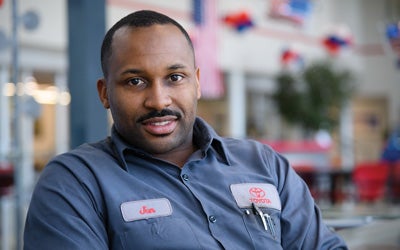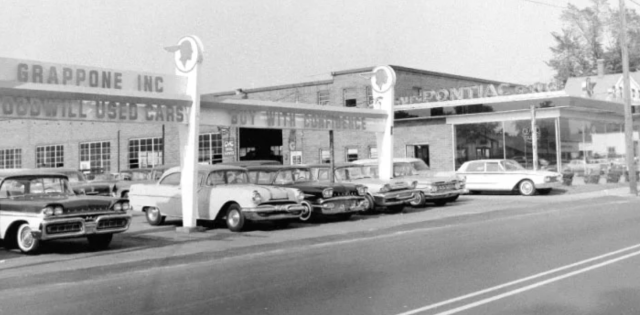Jonathan Biggom knows all about the great careers available in the retail automobile industry. The senior service technician at Motorcars Toyota, Cleveland, got hooked on working on cars when he took part in a vocational program during high school.
After graduation, Biggom elected not to go to a traditional four-year college—“I wanted to do something with my hands,” he explains in a recent NADA video—and instead enrolled in an accelerated automotive service course at a technical college. Thirteen years later, Biggom has worked his way up the career ladder. “You definitely see the progression. It’s rewarding,” he says.
But for every Jonathan Biggom out there, there are thousands of other smart, hardworking people who don’t know about the careers available at new-car dealerships or have misconceptions about the work they would do. As a result, hundreds of dealership positions go unfilled because owners and managers can’t find trained employees to take these high-paying positions.
“One of the biggest issues as employers is how to recruit, train and retain the best people” says 2019 NADA Chairman Charlie Gilchrist, president of Gilchrist Automotive in the Dallas-Fort Worth area, about a new initiative the NADA Foundation is launching at NADA Show 2019 to help solve the problem. “Every dealer feels that shortage today. It’s across the gamut. We need salespeople, parts people, accounting, body shop, in every department we need great people. If we don’t have a workforce, we don’t have a future.”

Senior service tech Jonathan Biggom launched his dealership career 13 years ago after taking an automotive service course at a technical college.
A Numbers Game
There’s no doubt the economy is booming and firing on all cylinders, which makes it even more difficult to attract young adults to the automotive industry. The national unemployment rate is the lowest it’s been in 50 years, hovering at around 3.7 percent, according to the Bureau of Labor Statistics (BLS). The labor force participation rate—the share of adults who are either employed or actively looking for work—is at 62.8 percent, or full employment. The labor force participation for prime-age workers, aged 25 to 54, is even higher, at 89 percent for men and 75.8 percent for women.
Dealerships are doing their part. Through the first half of 2018, the nation’s 16,794 franchised new-car dealerships employed more than 1.1 million people, up 0.8 percent from the same period a year ago, according to NADA Data 2018: Midyear Report. The average annual earnings for employees at new-car dealerships was $71,916 per year in 2017, up from $69,784 in 2016, a 3.1 percent increase.
From the shipyards of southern Virginia to the tech corridors of California, every industry is competing to attract the nation’s brightest young people. “What we’re seeing is the level of technician required to work on these cars is a higher-level technician, so there is competition to attract people into this market,” says Beno Rubin, director of the Regional Automotive Center at Tidewater Community College in Chesapeake, Va. Rubin gets approximately 80-100 new students every fall enrolled in one of five manufacturer programs, all of whom are hired immediately upon graduation. “The same skill set you need now to work on a vehicle is the same skill set you need in many, many different industries, so there are a lot more choices out there.”
The Most-Urgent-Skills Crisis Is Here
When it comes to service technicians, the shortage of personnel at the dealership is particularly acute. “Eventually we’re going to end up selling cars with no one in the service department to fix them,” says Bob Atwood, service instructor at the NADA Dealer Academy. “There is a severe shortage of technicians because the trade schools have not kept up with demand. Right now we need 60,000 technicians yesterday, and it’s not going to get any better.”
There are currently some 750,000 auto service techs in the country, BLS reports. With vacancies left by retirees and new jobs being created, 76,000 new service techs are needed per year. Yet existing training programs are only graduating 39,000 of them, creating an industry-wide shortage of 37,000 new techs each year.
The only way to counteract this trend and eliminate the shortfall is to get more students into service tech training programs. Yet enrollment at many community colleges and technical schools, which experienced a boom during the Great Recession, has declined slightly over the last few years as the economy has improved. “When the economy is good, you don’t have a whole lot of people, specifically young people, lining up to get into this field, particularly in this [region], where you have a big tech sector and, of course, the federal government,” says Keith Brown, head of Northern Virginia Community College-Alexandria’s General Motors Automotive Service Education Program (GM ASEP). “I don’t think they’re aware of the benefits and the potential that is out there.”
Lack of Harmonized Messaging
That lack of awareness and information for potential students is a big issue for recruiting and training programs. Right now it is very difficult for someone interested in a service tech career to find clear information about its benefits, and how to gain the necessary training and certifications. Not only is there a lack of online information promoting these careers and the steps to take to get into one, but there’s also a lack of information on the scholarships available.
Industry-wide, there has not been a coordinated marketing effort when it comes to messaging and outreach. Currently, manufacturers, training centers, community colleges, certification programs and dealerships are all putting out their own information and doing their own outreach, often only referring to training centers or programs they’re partnered with and ignoring others.
“We interviewed dealers, tech schools and OEMs, and went online to see how technician careers were being promoted,” says Jonathan Collegio, NADA’s senior vice president of Public Affairs, whose department runs the NADA Foundation. “What we found was a lot of information, but none of it coordinated and all of it user-unfriendly—a real maze if you’re 24 years old and interested in a technician career.”
The bottom line: The auto industry needs to get out of its silos and get behind one coordinated effort to promote tech careers, says Collegio. “Most OEMs get this. We can make real progress if the industry works together, and the NADA Foundation is in the best position to lead this effort.”

Career satisfaction is a given in the service department at Sport Honda, Silver Spring, Md. Above: Ana Guerra (left) and Lolita “Lita” Johnson.
NADA Foundation’s Solution
Enter the NADA Foundation Workforce Initiative, which is dedicated to addressing the workforce shortage in the retail automotive industry through a large-scale, ongoing campaign to promote the value of dealership jobs, especially service tech jobs.
The NADA Foundation in 2018 pledged $250,000 to its Workforce Initiative and seeks to raise another $1 million from industry partners.
“When the NADA Foundation was doing its strategic planning and when we looked at all of the options for where we could have an impact, we knew that one of the ways we could help our dealerships and our industry is by confronting the challenges we have with workforce and particularly the technician shortage,” says NADA Foundation Chairman Annette Sykora, dealer principal of Smith South Plains Ford and Lincoln in Levelland, Texas, and a former NADA chairman. “One of the areas we identified was how fragmented the message was on the various platforms, particularly online. That’s an area where we can really take the lead and provide information on how challenging, dynamic and rewarding careers in automotive are.”
The NADA Foundation’s initiative includes a new website that will serve as a harmonized clearinghouse of information from automakers, training centers and dealerships. The website will tell a prospective service tech where every training facility is located, as well as what programs and scholarships are available. The National Institute for Automotive Service Excellence (ASE) was particularly helpful in providing information on training facilities, Sykora says.
A major hurdle has been the negative impression among younger prospective employees that careers in service tech involve working long, inflexible hours and are low-paying and not creative. To combat those inaccuracies, NADA has compiled a series of videos featuring working service techs talking not only about the careers they’ve built in the automotive industry but also about their lifestyle and life outside the dealership.
To get its message in front of potential tech students who represent key demographics—almost seven in 10 newly hired techs in 2016 were millennials, born between the early 1980s and early 2000s—NADA is undertaking a major digital media marketing campaign. For example, students currently enrolled in a community college who watch a YouTube video on how to put a turbo in a Honda will also see a recommendation or advertisement suggesting that they watch one of the NADA service tech videos as well. The goal: By finding the right demographics and targeting students digitally, the campaign will help steer those students toward enrolling in an auto tech program at their school.
Finally, the NADA Foundation Workforce Initiative will lead a coordinated effort with manufacturers and with other auto-industry associations to reach groups that influence the prospective service tech population, including high school guidance counselors, military separation officers and community colleges. NADA will market and exhibit at conferences and events that target those key influencers, such as the SEMA Show, the Association for Career & Technical Education’s CareerTech Expo and the American Association of Community Colleges Annual Convention.
Says Collegio, “The question we asked ourselves, is: As an organization, can we put a dent in this? Can we do something that will move the needle? The answer is a resounding yes.”
Workforce Initiative ABCs
Every year between 2016 and 2026 the retail automotive industry will need 76,000 new automotive service technicians to fill 46,000 new openings and replace 30,000 retirees, according to the Bureau of Labor Statistics. Yet the number of new technicians graduating from technical schools in 2016, for instance, was only 38,829. To help fill the gap, here’s what the NADA Foundation Workforce Initiative has planned:
- Dynamic new service tech website and videos. A comprehensive, engaging, brand-neutral website will allow prospective service techs to learn about the benefits of the career, watch high-quality videos featuring techs talking about both their work and lifestyle, and find out about training programs and scholarships.
- Digital media. An online strategy will target prospective techs with internet searches and targeted advertising on key digital media platforms like Facebook, Instagram and Youtube.
- Economic research. Identifying key workforce needs will lead to improvements in tech recruitment and training.
- Marketing materials. Top-notch, brand-neutral print marketing materials will explain the benefits of service tech careers and steps to become a tech at different skill levels—and will be disseminated to training programs, dealerships, auctions and others to brand as their own or in partnership with the NADA Foundation.
- Outreach. An outreach strategy will encompass key “train the trainer” events, including annual conferences for guidance counselors, technical schools and community colleges, military separation officers, and other key groups.
- Career fairs. Local service tech career fairs are being considered for key areas across the country.
Down the road, the NADA Foundation Workforce Initiative will broaden to promote the benefits not only of tech careers but all dealership occupations, from receptionists to managers.










